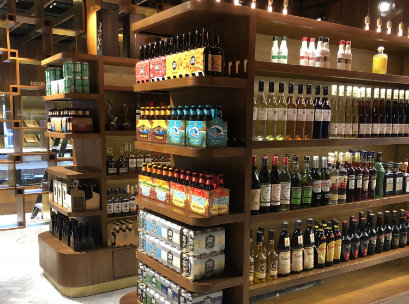The $102 billion food and grocery sector is a tough market. Just ask Coles, who reported a third quarter sales increase of just 1.9 per cent in late April.
The entry of German discounter Aldi and a decade ‘price wars’ has produced a price-conscious consumer, who regularly switches between supermarket brands seeking the lowest price. As Kaufland gears up for entry into the Australian market, the one thing we can be sure of is that things are going to get tougher for incumbent players.
A new direction
Eyebrows must have been raised back in 2016, when department store David Jones signaled plans to enter this crowded market. A tactical error, or an astute decision?
Then-chief executive John Dixon and managing director of food Pieter de Wet believed they had identified a gap in the Australian grocery market and looked to exploit it with David Jones Food Halls, a respectful nod to the iconic Marks & Spencers’ Food Halls.
Across Brisbane, there is a growing hunger for premium grocers like The Stores at West End and James Street Market, and on Saturday November 3, Brisbane shoppers will be introduced to a new offering with the launch of Mercado in Bowen Hills.
From one extreme to the other
Like the UK and Europe, the Australian grocery market has split into ‘discounters’ at one end and ‘mainstream supermarkets’ at the other.
While the growth of discounter-style grocers continues to outperform supermarkets globally, the ‘premium’ market in Australia appears ripe for exploitation and signals the ever-changing face of the Australian food and grocery landscape.
Globalisation, innovation, multiculturalism, media, travel and the internet have all helped shift the power from the retailer to the consumer. Reality television cooking shows and gourmet food markets tempt shoppers to seek out exclusive, unique food experiences.
Retailers develop brands to meet demand from consumer segments. If the segment is viable, ultimately the brand succeeds.
IBIS World examined key consumer segments (referred to as ‘quintiles’) who purchase food and groceries. The analysis is based on revenue derived from these major consumer segments as a percentage of total supermarket industry revenue – which accordingly provides an indication of the size of each market.
The first and second income quintile spend the highest proportion of their reasonably low income on food and groceries, and represent nearly 24 per cent of the revenue to the sector. This segment of shoppers are attracted to lower priced private label products and have become regular Aldi shoppers.
The third quintile of household income earners consists of low-to medium-income families and represents 19 per cent of industry revenues. This group is likely to purchase a range of both private label and branded products, and is often attracted to weekly specials and deep discounting. The fourth income quintile, representing over 24 per cent of industry revenue, comprises larger families and busy time-poor professionals. This group seeks convenience, click-and-collect transactions, ready-made meals and meal solutions.
The final quintile currently contributes over a third of supermarket revenues and represents the highest 20.0 per cent of household incomes. While this consumer allocates the lowest percentage of their sizable income on groceries, they spend the greatest amount in absolute terms. Supermarkets have increasingly expanded the range of premium products in-store to boost demand from this market. It is this segment Mercado will target and serve.
Value is not just about low price
While ‘price’ has certainly been the driver of Australian supermarket growth and market share over the past decade, in recent months we have seen both major brands subtlety move away from focusing on this attribute to an emphasis on other important aspects of their offer; such as freshness, range, quality, service and convenience.
Globally, supermarkets that have leveraged a premium strategy selectively have found it successful in cushioning the effects of competitors increased price discounting. Juice bars, free wine tasting, premium products and local food feature in UK supermarket Waitrose’s bid to continue to grow in a grocery market increasingly driven by discounters like Aldi and Lidl.
Similarly, US supermarket Whole Foods repositioned itself as the “healthiest grocery store” before being snapped up by Amazon in August 2017.
In Australia, NSW grocer Harris Farms has positioned themselves as having ethical consumption attributes, like sustainability, supporting communities and farmers. Frewville’s Foodland in Adelaide continues to win international awards, not on price but on building strong partnerships, unwavering quality, integrity and shared values.
Great strategy or risky move
Entry into the food and grocery sector without careful planning would be a risk for David Jones given the current competitive nature of the sector. However, it looks like they have the right team and expertise to pull this off. The biggest issue David Jones will face is the lack of an extensive supplier base. Unlike their general merchandise and apparel categories that source inventory overseas and import into a country, food retailers are highly dependent on domestic supply.
Previous attempts to launch an upmarket grocer in Australia have failed. Jones the Grocer’s Australian operations went bust in December 2014. Woolworths finally pulled the pin on their Thomas Dux Grocers in mid-2017. It is therefore reasonable to think that if Australia’s biggest food and grocery retailer, Woolworths, could not make it work, can David Jones?
Certainly one of the challenges Woolworths faced with their Thomas Dux venture was the costs incurred in ‘stand-alone’ sites, despite having premium locations in up-market suburbs. Revenues were simply not viable to support a stand-alone business. While David Jones has hinted at potentially opening a stand-alone version, their immediate strategy will be to open ‘Food Halls’ in existing stores. A smart move, considering traditional departments store categories like apparel, bedding and consumer electronics have been severely impacted by global fast fashion retailers and category killers, like Harvey Norman and JB Hi-Fi. They have available space, existing leases and such a move will allow them to reduce the foot print of loss making categories.
Clearly, targeting shoppers seeking premium, exclusive food products will represent a very small but profitable segment – if well executed. Careful selection of store locations and securing supplier support could drive long-term growth for Woolworths SA. Following a Marks & Spencer model, possibly co-located food stores within David Jones department stores, may be the safest way to enter the market.
Food remains a dynamic sector
It is evident that Australia is becoming an attractive market for international food and grocery retailers, with its growing middle class, multi-cultural tastes and relatively strong economy. Global players such as Aldi and Costco have already set up shop and continue to expand. Kaufland is about to launch and rumours still surround whether Lidl will follow, after Kaufland establishes itself within the market. As the food and grocery segment continues to offer up new segments, new players will continue to enter, bringing with them greater choice for consumers and stronger bargaining power for suppliers.







